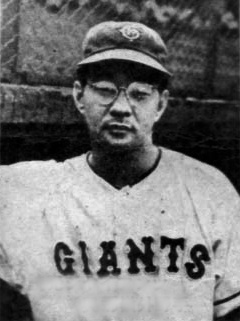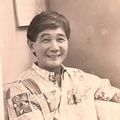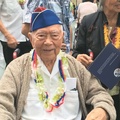If the Reverend Takie Okumura viewed the game of baseball as a vehicle for “Americanizing” Hawaii’s Japanese community, the founder of the Makiki Christian Church underestimated the pure, unadulterated draw of the game. The recorded history of Japanese American involvement in baseball in Hawaii dates back to 1899, the year Okumura formed a team made up primarily of boys who boarded at his Okumura Home. He named the team Excelsior, and they captured the youth league championship in 1905.
The Riverside League, made up of four ethnic teams from the ‘A’ala area, was formed a year later. It included the Nihonjin Gumi, Chinese Palama, Chinese Aloha, and Hawaiian Independents. Much of the early history of Americans of Japanese Ancestry (AJA) baseball is recorded in two volumes titled The Japanese Balldom of Hawaii, written in 1919 and 1940 by Rev. Chimpei Goto, a student at the Nu‘uanu Japanese School operated by Rev. Okumura. Goto loved baseball and documented Japanese involvement in it.
AJA involvement in baseball took off in subsequent years, and it did indeed become the favorite pastime of at least one group of Americans: those of Japanese ancestry. Beginning in the early 1900s and including participation in the plantation leagues, Hawaii’s AJA League, school-sanctioned baseball, and even today’s Little Leagues, Japanese Americans have been part of it all.
But First There Was the Asahis …
But first there was the Asahis, a ragamuffin group of young teens from the Kalihi-Palama area of Honolulu, which future territorial and state legislator Steere G. Noda had organized into a team in 1903, when he was just 13 years old. The team got its name in 1905 and entered league play in 1907; at the time, there were already 30 or 40 all Japanese teams playing in various leagues. The first year of league play was a struggle for the Asahis, but their luck changed the following year when the AJA Baseball League was established. They captured the league championship that year. The players continued to hone their skills. Finally, in 1911 the Asahis captured the O‘ahu Junior League championship, a feat repeated for the next three years.
In 1915 the Asahis played their first game abroad in Yokohama, Japan. The players had scraped together the 50-dollar third-class boat passage from their savings and from nickel-and-dime donations that had been tossed into a hat by fans at their games; the balance they borrowed from their families. The Asahis three month stay in Japan was a productive one, as they beat Yokohama’s best team and compiled an 8 and 6 record.
The Asahis’ winning streak continued in the O‘ahu Junior League until they were forced to move up into Senior League play. The team joined the Honolulu Baseball League in 1920 and clinched the league championship four years later. In 1925 the Asahis joined the newly organized Hawaii Baseball League (HBL), which was made up of ethnic teams; the All-Hawaiians, the All-Chinese, the Braves (Portuguese), the Wanderers (Caucasian), and the All-Filipinos, which joined the HBL later. The Asahis continued to push forward, taking back-to-back Hawaii Baseball League championships in 1925 and 1926.
In 1933, University of Hawaii researcher Margaret Lum noted that the ethnic competition within the Hawaii Baseball League had led to a “subtle change in the attitude of onlookers with regard to the racial group concerned… With such a gradual change of attitude toward certain races, we find naturally more tolerance, and tolerance leads ultimately to recognition of each group’s status in a community of vari-colored ‘nations.’”
Ironically, however, that same year, the issue of race put Asahi fans on opposite sides of the fence. At the center of the controversy was Ted Shaw, an outstanding southpaw pitcher who had played with the Philadelphia Royal Giants of the Negro League. Shaw had fallen in love with the islands after playing an exhibition game in Hawai‘i—so much so that he decided to stay. He was hired as a player for a team in Hawaii’s Commercial League, and he also played for the all-haole (Caucasian) Wanderers of the Hawaii Baseball League, but what he wanted most was to play for the Asahis—and in 1933, the team was in dire need of the powerhouse pitcher like Shaw.
League officials could not agree on how to settle the issue, so the Asahis decided to let their fans decide. How the final decision was made is unclear. There were impassioned arguments on both sides of the issue, many of them reported in the Japanese daily newspaper, Hawaii Hochi, Bill Raposa, official scorekeeper for the Hawaii Baseball League, supported Shaw:
The Hawaii League wants to make itself a paying proposition. In that case, the Asahis MUST be strong. A weak Asahi team will never draw the fans in for the Hawaii League. That being the case, the Asahis could do well to take in Ted Shaw. Shaw wants to play and several members of the Asahis want him to play. Shaw will make the Asahis a real pennant contender, for outside of pitching, I think the Asahis have the best team in the league. Without pitching, they are a good second-division club.
Raposa noted that other league members were willing to let Shaw play for the Asahis, including the president of Shaw’s own team, the Wanderers. Baseball fans expressed their opinions in emotion-filled letters to the editor, such as this one:
Reading your article on the Asahis burned me up. I wanted to take a sock at the guys who wanted the Asahis to change their status. I, for one, am strong for the Asahis to stick as they are, win, lose or draw. Asahi for Japanese is my motto and that’s how I’ll be when September rolls around. You tell the Asahis bigshots that the fans won’t tolerate such a thing. Don’t you see? It’s absolutely too funny for words. Very angrily, H. Togo
Asahi fans ultimately rejected Shaw’s becoming a member of the team. Ted Shaw remained in Hawai‘i and later worked as a pitching coach at Iolani School under Father Bray. He also served for many years as an AJA League umpire.
The issue of race surfaced again in 1936 when Dr. Katsumi Kometani, then owner and president of the Asahis, appointed Neal S. Blaisdell as the team’s coach. The Asahis had maintained an all-AJA policy that applied not only to its players but to its coaches and franchise owners as well. Hawaii Hochi sportswriter Percy Koizumi blasted Kometani for appointing Blaisdell:
….I never expected Dr. Kometani to go to such ends in order to bring a championship to the Asahis. I gave him credit for having more knowledge of Japanese fan psychology. I agree with Dr. Kometani that Blaisdell is a fine coach, but I hardly think this is the time for such an appointment.
Koizumi noted that there were many capable coaches of Japanese ancestry, and he stated further that many Hawaii Hochi readers had called him to express their displeasure with Kometani’s decision. Koizumi continued:
The Asahis have always been the only strictly one-race team in the internationally devised Hawaii League. The Asahis have a tradition to uphold. You might pass this up as a lot of hocus-pocus entertained by fossil-headed fans, but you’d be surprised to see how empty the stands will be if these fossil-heads decide to keep away.
The Asahis maintained an all-Japanese policy until 1942, when it was forced to recruit several haole players to placate anti-Japanese sentiments during World War II. In 1943 the Asahis were forced to change their name to the less-threatening “Athletics.”
All of these changes occurred ironically while the team’s owner, Dr. Katsumi Kometani, was fighting in Europe with the 100th Infantry Battalion. One of his comrades in arms was Asahi standout Shigeo “Joe” Takata, a popular longball hitter. The 24-year old Takata was killed in action a week after the 100th landed in Italy, the first AJA to be killed in action in the European theater. Before going overseas, however, Kometani had appointed John Burns as acting franchise owner and Neal S. Blaisdell as team manager. Two decades later Japanese Americans would play a major role in Burns’ election as Hawaii’s governor.
The team resumed play as the Asahis in 1947, returning to its policy of all-Japanese players, but they were never able to generate the kind of fan support and enthusiasm they had enjoyed prior to the war. They had lost their aura as the all-Japanese team with the entry of the all-Japanese Rural Red Sox into the Hawaii Baseball League in 1946. The Sox captured the HBL championship that same year.
Reluctantly, the Asahis opened their membership to players of all ethnic backgrounds in 1956, from these rosters emerged some of Hawaii’s finest baseball players, among them the legendary Wally Yonamine. With the debut of the Hawaii Islanders, a pro team, and the sprouting of a University of Hawaii baseball program headed by Les Murakami, a Hawai‘i Sansei who had played AJA League baseball as a kid, interest in the team led to the demise of the Asahis and the entire Hawaii baseball League in the 1970s.
Teamwork On and Off the Field
In his book Pau Hana: Plantation Life and Labor in Hawaii, Dr. Ronald Takaki notes that after the 1909 sugar strike the Hawaiian Sugar Planters Association (HSPA) began urging the planters to keep their workers occupied with recreational programs, such as baseball, as a means of staving off labor unrest. An H. Hackfield and Company vice president explained that “significant results” were attainable for plantation managers through activities like baseball “not only in holding the laborer on the plantation, but in preventing strikes.” He added: “Leaving out of consideration the humanitarian side of any such welfare work we believe it would be to the financial benefit of the plantation to endeavor to cultivate a spirit of contentment among the laborers.”
The HSPA repeated its recommendation following a 1920 strike and urged the planters to expand their recreational and welfare programs. “Social welfare work should be considered good business and not philanthropy,” the HSPA noted. Ironically, little did the planters realize the real role that baseball would play in union organizing of plantations workers by the international Longshoremen’s and Warehousemen’s Union (ILWU).
One of the most adept organizers was Hideo “Major” Okada, a standout Nisei pitcher from Waipahu who had attended Mid-Pacific Institute in Honolulu on an athletic scholarship. Okada had acquired his nickname, “Major”, at Mid-Pac, where his pitching skills were considered on par with major-league players. Okada had grown up in the shadow of the Oahu Sugar Mill, and after graduating from Mid-Pac had gone to work for the only real employer in Waipahu: Oahu Sugar.
In 1944, ILWU organizers Jack Kawano and Yoroku Fukuda asked Major to help them organize sugar workers on O‘ahu. He agreed to help, and he got several of his closest and most trusted friends to help him. His baseball buddies were his point people at the various plantations. At Wai‘alua Sugar, he turned to former player Mike Nagata and “Ghandi” Warashina, his old second baseman from Mid-Pac. Warashina rounded up other leaders, many of whom were initially reluctant to join the union. At Ewa Plantation Major called on pitcher Mike Ishizaki. The company fired Ishizake when they learned of his union-organizing activities.
Okada went to see ILWU leader Jack Hall about Ishizaki. Hall urged Major to continue organizing Ewa Plantation and assured him that the union would get Ishizaki reinstated, which it did.
There are some who believe that the AJA League actually grew out of the earlier Plantation League, an ethnically mixed league that saw most of its action in the early 1900s. The league represented sugar plantations in ‘Aiea, Waipahy, Ewa, Wai‘anae, Wai‘alua, Kahuku, and Waimanalo. Wahiawa joined later as “the pineapple team.” Players had to be good in order to make the cut, and many Japanese aspirants failed to qualify for the Plantation League. A separate AJA baseball league was thus created to give young Japanese American men an opportunity to play.
Japanese Only
The establishment of the AJA League in 1908 prompted the formation of a flood of new leagues and associations. Prior to the war, teams came and went: there were the Mo‘ili‘ili White Elephants, the Kalihi Koyus, and the Azuma Reds, one of the strongest prewar teams. Other prewar teams playing in the 1930s included Seibu, Palama, and Nippon.
Although the AJA League was committed to retaining its Japanese identity, it did allow hapa (mixed-race) boys to play—but only if their fathers were Japanese and they had a Japanese surname. There were no other opportunities for young Japanese American men to play baseball outside of the AJA League. One of the most notable hapa barred from playing was Joe Tom, whose father was Chinese. Tom had played football with Wally Yonamine at Farrington High School, where they were standouts in both football and baseball. He was able to play for the Asahis in the Hawaiian Baseball League when it began accepting non-Japanese players. The Japanese surname has since been relaxed, although league veterans cannot remember when the change occurred. Players must now be at least 10 percent Japanese to play.
Hawai‘i AJA Baseball: Gambatte!
Hawaii’s Japanese community supported AJA baseball in a big way, accounting as they did for 75 percent of the Hawaii Baseball League’s gate receipts as early as 1936. Baseball was one of the few sources of entertainment for the Japanese community at the time. For plantation workers who labored six days a week, going to the ballgame and watching the local nihonjin (Japanese) boys cut loose on their field of dreams was a treat, well worth every bit of the quarter they paid for admission.
The league’s Hoholulu games were played on Sundays at the old Honolulu Stadium, which it rented for $100. Attendance averaged more than a thousand fans every week. Eager fans would rubberneck from the open-air streetcars as they traveled down King Street to Honolulu Stadium, and it was not uncommon for people to walk several miles from downtown Honolulu to the stadium in Mo‘ili‘ili to catch the games. Issei parents, their neighbors, and other family members and friends packed the stadium and rural playing fields to watch Hawaii’s AJA boys breathe their own brand of magic into America’s favorite pastime. The better players were looked up to as heroes in the community.
AJAs loved their baseball and were proud of their teams, as evidenced by the more than 150 people who crowded into the home of Pearl City manager Kazue Minami to celebrate the team’s clinching of the 1947 Rural League championship. The games were so popular that they even generated some wagering, with the odds oftentimes published in the Japanese newspapers. Many Issei would often bet a dollar in one of the betting pools at Honolulu Stadium. Although the activity was illegal, officials tended to look the other way shrugging it off as part of the excitement of the game.
Both O‘ahu leagues, Honolulu and Rural, consisted of a maximum of 6 teams, or franchises, each with about 18 to 20 players. The Rural League teams—‘Aiea, Pearl City, Waipahu, Ewa, Wa‘alua, and Wahiawa—played their games at community baseball fields. Although the rural fields lacked the prestige and romance of a Honolulu Stadium, they never lacked for colorful games and enthusiastic fans. In fact, some 3,000 fans converged on the ‘Aiea field to watch powerhouse Waipahu beat Pearl City in a regular season game in 1948. Play-off games attracted about 3,000 spectators to Honolulu Stadium, while more heated match-ups brought out as many as 4,000 spectators, each of whom paid a dollar for admission. Seating was open, with the best seats going to the early birds. In 1941 some 5,000 fans turned out to watch Pearl City win the O‘ahu AJA baseball championship.
AJA baseball games weren’t simply sports contests, they were community gatherings. For example, in an effort to raise funds for handicapped children, contestants in the annual Cherry Blossom Festival culture and beauty contest fanned out into the stands, collecting cash donations from the crowd.
The games also attracted some big name spectators from Japan, such as baseball legend Sadaharu Oh, who dropped in on an AJA League game at Honolulu Stadium in the 1960s. Popular samurai film star Hashizo Okawa also made and appearance one year, and the game was halted for a short while to acknowledge his presence. The actor spoke to the crowd in Japanese, sending his fans into seventh heaven.
* This essay was adapted from two articles published in the Hawaii Herald on June 7 and 21, 1996 and published in More Than A Game in 2000 by the Japanese American National Museum.
© 2000 The Japanese American National Museum






